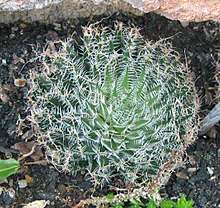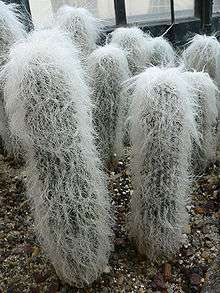Arachnoid (botany)
Arachnoid as a descriptive term in botany, refers to organs such as leaves or stems that have an external appearance similar to cobwebs from being covered with fine white hairs, usually tangled. Such material is one common cause of plants having a grey or white appearance.[1] The usages of various authors in distinguishing between "arachnoid" and a few other terms referring to hairiness, such as floccose, pubescent, tomentum, cottony, or villous, tend to be arbitrary, but as a rule the term is best reserved for hairiness lighter than a felted layer, and inclined to rub off or to be easily damaged in other ways. The arachnoid appearance is common on the leaves and stems of various sclerophyllous members of the Asteraceae, such as some thistles.


Nonetheless, "cobwebbiness" is a subjective impression, and in the likes of Hayworthia arachnoidea the arachnoid impression arises from the thicket of spinescent leaf denticles that are not at all fine, tangled, or fragile. In the cactus Cephalocereus senilis, the arachnoid effect arises from long-lasting hairy spines.
References
- Jackson, Benjamin, Daydon; A Glossary of Botanic Terms with their Derivation and Accent; Published by Gerald Duckworth & Co. London, 4th ed 1928
See also
- Arachnoid (disambiguation)